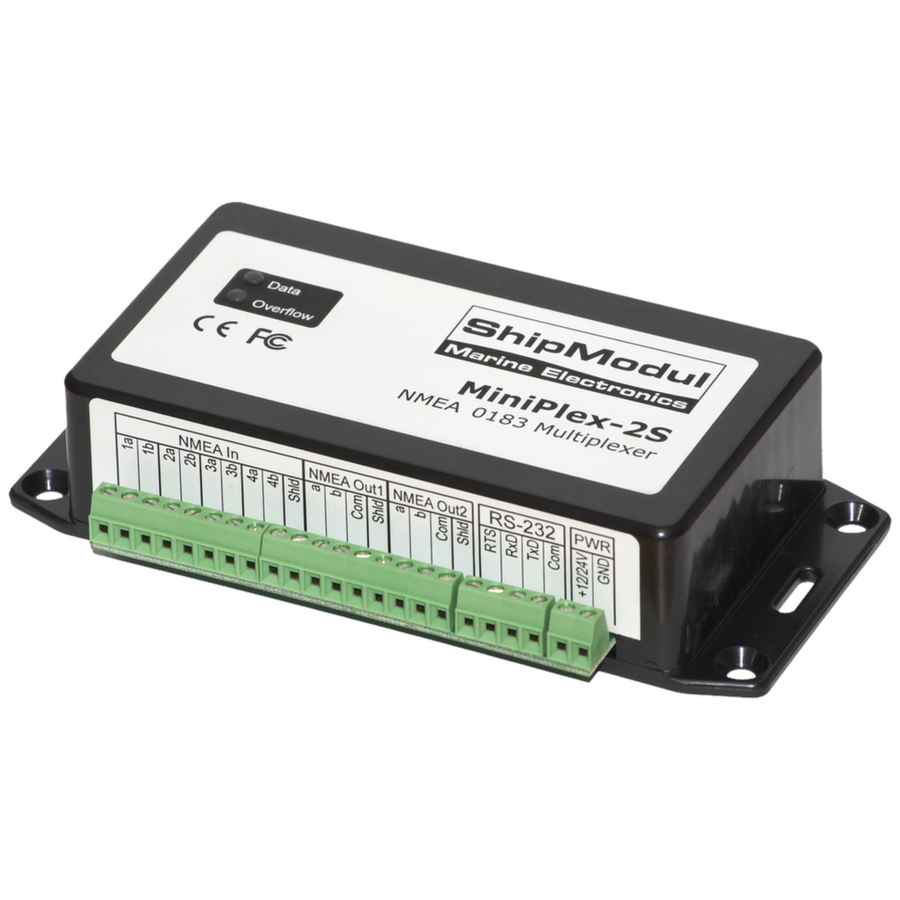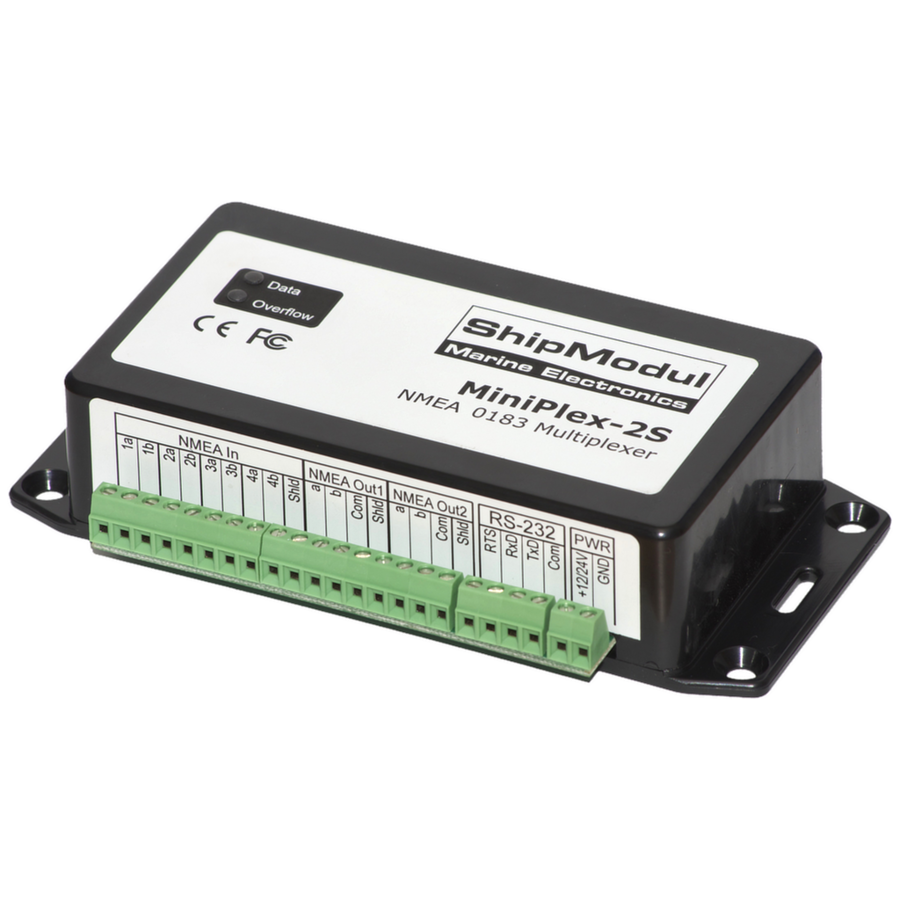
MiniPlex-2S
The MiniPlex-2S is an advanced multiplexer which combines NMEA 0183 data from multiple sources into one stream.
It also has two NMEA 0183 outputs and an RS232 port, and received NMEA 0183 sentences can be individually be routed to each of these outputs.
The RS232 port is bi-directional, so it can transmit NMEA 0183 data to a connected computer and at the same time, it can receive NMEA 0183 data to be routed to one or both NMEA 0183 outputs.
Communication speeds up to 57600 baud are supported (Out 2 and RS232 go up to 115200).
Input 4 can be set to SeaTalk mode, so it can receive SeaTalk data and convert it into NMEA 0183.
A comprehensive set of features include routing/filtering of NMEA 0183 sentences, numerous conversions, prioritisation of data etc. make the MiniPlex-2S the ultimate solution for any interfacing requirement.
| NMEA routing | NMEA data can be routed from any input to any output. A default route can be set as well as specific routing rules for individual NMEA sentences. Computer data can be routed to any NMEA output, to be merged with other NMEA data or to override this data. This enables automatic switching between computer based navigation and GPS/instrument based navigation. |
| NMEA filtering | A flexible NMEA filter can be configured to pass or block specific sentences from each input channel. This greatly reduces the chance of an overflow and the resulting loss of data. Many GPS receivers for instance, transmit an abundance of sentences every second, accounting for 85% of the available bandwidth of the NMEA channel. By blocking unwanted or unnecessary sentences, bandwidth is preserved for other instruments. The filter can also be configured to reduce the rate of specific NMEA sentences. |
| Flexible communication speed | The communication speed of all inputs and outputs can be set from 4800 to 57600 Baud to allow connection of devices that operate at non-standard (4800 Baud) communication speeds like integrated weather sensors, gyrocompasses or AIS equipment. |
| SeaTalk® conversion | When the SeaTalk -> NMEA option is enabled, one of the NMEA inputs becomes a SeaTalk® compatible input, offering conversion of the most common SeaTalk datagrams on a Raymarine® network into NMEA sentences. This data is combined with NMEA data received on the other inputs. When Priority is enabled, SeaTalk data can be assigned highest or lowest priority. |
| Real-Time forwarding | Gyro- and fluxgate compasses produce NMEA sentences at a high rate (10 sentences/second or more). This can lead to a buffer overflow in the multiplexer. Although this overflow is handled properly without data corruption, it will lead to a delay of NMEA sentences of up to 20 seconds in extreme situations. This produces a severe problem for autopilots, which cannot make proper course corrections when their heading feedback is delayed for 20 seconds. The Real-Time option prevents this delay by bypassing the buffer of that specific channel and forwarding the data immediately to the multiplexer's NMEA output. As a result, the heading is never delayed more than 0.2 to 0.5 seconds, depending on the amount of other NMEA sentences passing through the multiplexer. |
| Heading conversion | This option converts a Magnetic Heading sentence (HDG) into a True Heading sentence (HDT). If the originating magnetic heading sentence contains a magnetic variation, it is used to calculate the true heading before conversion. This feature is useful for certain equipment like VDR's which need a true heading input, while the only available heading source is a fluxgate, delivering a magnetic heading. |
| Priority | With Priority enabled, similar NMEA sentences on different inputs are only passed from the input with the highest priority. The RS-232 port has the highest priority, followed by inputs 1 to 4, in descending order. When for instance two GPS receivers are connected to inputs 1 and 2, and both transmit the same type of NMEA sentences, only those received on input 1 are passed. An adjustable time-out ensures that similar sentences from the GPS at input 2 are passed when the GPS at input 1 stops sending these sentences. Optionally, GPS sentences are checked for a valid status field, causing automatic switchover when the primary GPS looses satellite signal. |
| Channel information | When this feature is switched on, the multiplexer will transmit a proprietary NMEA sentence indicating on which input channel the following NMEA sentence is received. Optionally, the multiplexer can append NMEA V4.0 TAG block to each NMEA sentence to indicate its originating input. |
| Talker ID substitution | Talker ID substitution changes the talker ID of incoming sentences. The talker ID can be specified for each input channel. This option is useful for software or instruments that expect a specific talker ID or to distinguish between sentences from two similar instruments. |
Specifications
| MiniPlex-2S Technical specifications | |
|---|---|
| Supply voltage: | 8-35 VDC, protected against reversed polarity |
| Current consumption: | 50 mA (100 mA max. with fully loaded talker ports) |
| Host interface: | RS232, galvanically isolated |
| Inputs: | 4 x NMEA 0183/RS422, galvanically isolated In 4 can be set to SeaTalk mode |
| Input resistance: | > 800 Ohm |
| Input current: | 1.2 mA @ 2 V |
| Outputs: | 2 x NMEA 0183/RS422 |
| Max ouput current: | 20 mA @ > 2 V |
| Routing table size: | 50 sentence types |
| Priority table size: | 50 sentence types |
| Speed NMEA 0183 In 1 - 3: | 4800 - 57600 baud |
| Speed NMEA 0183 In 4/Out 1: | 4800 - 57600 baud |
| Speed NMEA 0183 Out 2: | 4800 - 115200 baud |
| Indicators: | Overflow and Data |
| Housing: | Flame retardant ABS |
| Dimensions: | 138 x 62 x 30 mm |

